Custom List, displaying data your way
- create a custom editor
- use
SerializedObject - manipulate a
SerializedPropertythat represents an array or list - use an enumeration for option flags
- use GUI buttons
This tutorial comes after the Custom Data tutorial.
This tutorial is for Unity version 4.3 and above.

Creating Test Data
We start with the finished Custom Data tutorial project, or by creating a new empty project and importing custom-data.unitypackage.
Then we create a new test script named ListTester with some test arrays, and make a new prefab and prefab instance with it, so we can see it all works as expected.
using UnityEngine;
public class ListTester : MonoBehaviour {
public int[] integers;
public Vector3[] vectors;
public ColorPoint[] colorPoints;
public Transform[] objects;
}

Creating a Custom Inspector
UnityEditor.Editor, and apply the UnityEditor.CustomEditor
attribute to tell Unity that we want it to do the drawing for our component.
using UnityEditor;
using UnityEngine;
[CustomEditor(typeof(ListTester))]
public class ListTesterInspector : Editor {
}
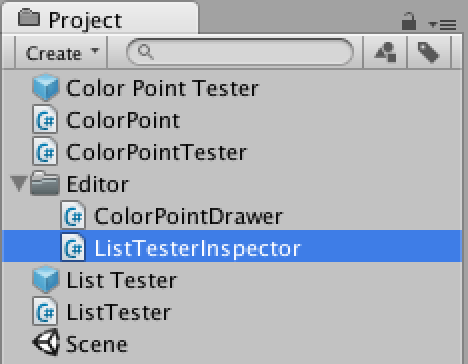
OnInspectorGUI method of the
Editor class. Leaving the method empty will result in an empty inspector as well.
public override void OnInspectorGUI () {
}

SerializedObject instead of a single
SerializedProperty. Secondly, an instance of the editor exists as long as the object
stays selected, keeping a reference to its data instead of getting it via a method parameter.
Finally, we can use EditorGUILayout, which takes care of positioning for us.
We can get to the serialized object via the serializedObject property.
To prepare it for editing, we must first synchronize it with the component
it represents, by calling its Update method. Then we can show the properties.
And after we are done, we have to
commit any changes via its ApplyModifiedProperties method. This also takes care
of Unity's undo history. In between these two is where we'll draw our properties.
public override void OnInspectorGUI () {
serializedObject.Update();
EditorGUILayout.PropertyField(serializedObject.FindProperty("integers"));
EditorGUILayout.PropertyField(serializedObject.FindProperty("vectors"));
EditorGUILayout.PropertyField(serializedObject.FindProperty("colorPoints"));
EditorGUILayout.PropertyField(serializedObject.FindProperty("objects"));
serializedObject.ApplyModifiedProperties();
}

PropertyField
doesn't show any children – like array elements – unless we tell it to do so.
public override void OnInspectorGUI () {
serializedObject.Update();
EditorGUILayout.PropertyField(serializedObject.FindProperty("integers"), true);
EditorGUILayout.PropertyField(serializedObject.FindProperty("vectors"), true);
EditorGUILayout.PropertyField(serializedObject.FindProperty("colorPoints"), true);
EditorGUILayout.PropertyField(serializedObject.FindProperty("objects"), true);
serializedObject.ApplyModifiedProperties();
}
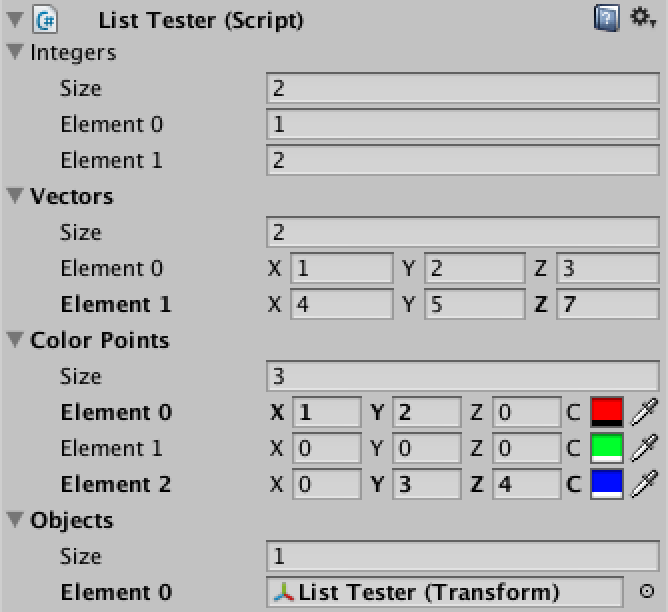
Creating an Editor List
PropertyField method. We will name this method Show and put it in its
own static utility class, so we can use it wherever we want. We'll name this class
EditorList and place it in the Editor folder.
using UnityEditor;
using UnityEngine;
public static class EditorList {
public static void Show (SerializedProperty list) {
}
}
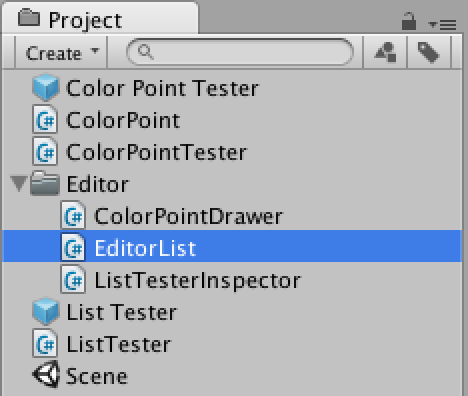
public override void OnInspectorGUI () {
serializedObject.Update();
EditorList.Show(serializedObject.FindProperty("integers"));
EditorList.Show(serializedObject.FindProperty("vectors"));
EditorList.Show(serializedObject.FindProperty("colorPoints"));
EditorList.Show(serializedObject.FindProperty("objects"));
serializedObject.ApplyModifiedProperties();
}
EditorGUILayout.PropertyField without having it
show the children of the list. Then we can show the list elements ourselves with help of the
arraySize property and the GetArrayElementAtIndex method of
SerializedProperty. We'll leave the size for later.
public static void Show (SerializedProperty list) {
EditorGUILayout.PropertyField(list);
for (int i = 0; i < list.arraySize; i++) {
EditorGUILayout.PropertyField(list.GetArrayElementAtIndex(i));
}
}

Properly Indenting
public static void Show (SerializedProperty list) {
EditorGUILayout.PropertyField(list);
EditorGUI.indentLevel += 1;
for (int i = 0; i < list.arraySize; i++) {
EditorGUILayout.PropertyField(list.GetArrayElementAtIndex(i));
}
EditorGUI.indentLevel -= 1;
}

ColorPointDrawer behaves well.
public override void OnGUI (Rect position, SerializedProperty property, GUIContent label) {
int oldIndentLevel = EditorGUI.indentLevel;
label = EditorGUI.BeginProperty(position, label, property);
Rect contentPosition = EditorGUI.PrefixLabel(position, label);
if (position.height > 16f) {
position.height = 16f;
EditorGUI.indentLevel += 1;
contentPosition = EditorGUI.IndentedRect(position);
contentPosition.y += 18f;
}
contentPosition.width *= 0.75f;
EditorGUI.indentLevel = 0;
EditorGUI.PropertyField(contentPosition, property.FindPropertyRelative("position"), GUIContent.none);
contentPosition.x += contentPosition.width;
contentPosition.width /= 3f;
EditorGUIUtility.labelWidth = 14f;
EditorGUI.PropertyField(contentPosition, property.FindPropertyRelative("color"), new GUIContent("C"));
EditorGUI.EndProperty();
EditorGUI.indentLevel = oldIndentLevel;
}

Collapsing Lists
isExpanded property of our list.
public static void Show (SerializedProperty list) {
EditorGUILayout.PropertyField(list);
EditorGUI.indentLevel += 1;
if (list.isExpanded) {
for (int i = 0; i < list.arraySize; i++) {
EditorGUILayout.PropertyField(list.GetArrayElementAtIndex(i));
}
}
EditorGUI.indentLevel -= 1;
}

Showing the Size
public static void Show (SerializedProperty list) {
EditorGUILayout.PropertyField(list);
EditorGUI.indentLevel += 1;
if (list.isExpanded) {
EditorGUILayout.PropertyField(list.FindPropertyRelative("Array.size"));
for (int i = 0; i < list.arraySize; i++) {
EditorGUILayout.PropertyField(list.GetArrayElementAtIndex(i));
}
}
EditorGUI.indentLevel -= 1;
}

Customizing the List
public static void Show (SerializedProperty list, bool showListSize = true) {
EditorGUILayout.PropertyField(list);
EditorGUI.indentLevel += 1;
if (list.isExpanded) {
if (showListSize) {
EditorGUILayout.PropertyField(list.FindPropertyRelative("Array.size"));
}
for (int i = 0; i < list.arraySize; i++) {
EditorGUILayout.PropertyField(list.GetArrayElementAtIndex(i));
}
}
EditorGUI.indentLevel -= 1;
}
public override void OnInspectorGUI () {
serializedObject.Update();
EditorList.Show(serializedObject.FindProperty("integers"));
EditorList.Show(serializedObject.FindProperty("vectors"));
EditorList.Show(serializedObject.FindProperty("colorPoints"), false);
EditorList.Show(serializedObject.FindProperty("objects"), false);
serializedObject.ApplyModifiedProperties();
}

public static void Show (SerializedProperty list, bool showListSize = true, bool showListLabel = true) {
if (showListLabel) {
EditorGUILayout.PropertyField(list);
EditorGUI.indentLevel += 1;
}
if (!showListLabel || list.isExpanded) {
if (showListSize) {
EditorGUILayout.PropertyField(list.FindPropertyRelative("Array.size"));
}
for (int i = 0; i < list.arraySize; i++) {
EditorGUILayout.PropertyField(list.GetArrayElementAtIndex(i));
}
}
if (showListLabel) {
EditorGUI.indentLevel -= 1;
}
}
public override void OnInspectorGUI () {
serializedObject.Update();
EditorList.Show(serializedObject.FindProperty("integers"), true, false);
EditorList.Show(serializedObject.FindProperty("vectors"));
EditorList.Show(serializedObject.FindProperty("colorPoints"), false, false);
EditorList.Show(serializedObject.FindProperty("objects"), false);
serializedObject.ApplyModifiedProperties();
}

Using Flags
The first thing we need to do is create an enumeration of all our options. We name it
EditorListOption and give it the System.Flags attribute. We place it in its
own script file or in the same script as EditorList, but outside of the class.
using UnityEditor;
using UnityEngine;
using System;
[Flags]
public enum EditorListOption {
}
|.
[Flags]
public enum EditorListOption {
None = 0,
ListSize = 1,
ListLabel = 2,
Default = ListSize | ListLabel
}
Show method can now be replaced with a single options
parameter. Then we'll extract the individual options with the help of the bitwise AND operator
& and store them in local variables to keep things clear.
public static void Show (SerializedProperty list, EditorListOption options = EditorListOption.Default) {
bool
showListLabel = (options & EditorListOption.ListLabel) != 0,
showListSize = (options & EditorListOption.ListSize) != 0;
if (showListLabel) {
EditorGUILayout.PropertyField(list);
EditorGUI.indentLevel += 1;
}
if (!showListLabel || list.isExpanded) {
if (showListSize) {
EditorGUILayout.PropertyField(list.FindPropertyRelative("Array.size"));
}
for (int i = 0; i < list.arraySize; i++) {
EditorGUILayout.PropertyField(list.GetArrayElementAtIndex(i));
}
}
if (showListLabel) {
EditorGUI.indentLevel -= 1;
}
}
public override void OnInspectorGUI () {
serializedObject.Update();
EditorList.Show(serializedObject.FindProperty("integers"), EditorListOption.ListSize);
EditorList.Show(serializedObject.FindProperty("vectors"));
EditorList.Show(serializedObject.FindProperty("colorPoints"), EditorListOption.None);
EditorList.Show(serializedObject.FindProperty("objects"), EditorListOption.ListLabel);
serializedObject.ApplyModifiedProperties();
}
Hiding the Element Labels
[Flags]
public enum EditorListOption {
None = 0,
ListSize = 1,
ListLabel = 2,
ElementLabels = 4,
Default = ListSize | ListLabel | ElementLabels,
NoElementLabels = ListSize | ListLabel
}
Show method is extract this option and perform a simple
check. Let's also move the element loop to its own private method, for clarity.
public static void Show (SerializedProperty list, EditorListOption options = EditorListOption.Default) {
bool
showListLabel = (options & EditorListOption.ListLabel) != 0,
showListSize = (options & EditorListOption.ListSize) != 0;
if (showListLabel) {
EditorGUILayout.PropertyField(list);
EditorGUI.indentLevel += 1;
}
if (!showListLabel || list.isExpanded) {
if (showListSize) {
EditorGUILayout.PropertyField(list.FindPropertyRelative("Array.size"));
}
ShowElements(list, options);
}
if (showListLabel) {
EditorGUI.indentLevel -= 1;
}
}
private static void ShowElements (SerializedProperty list, EditorListOption options) {
bool showElementLabels = (options & EditorListOption.ElementLabels) != 0;
for (int i = 0; i < list.arraySize; i++) {
if (showElementLabels) {
EditorGUILayout.PropertyField(list.GetArrayElementAtIndex(i));
}
else {
EditorGUILayout.PropertyField(list.GetArrayElementAtIndex(i), GUIContent.none);
}
}
}
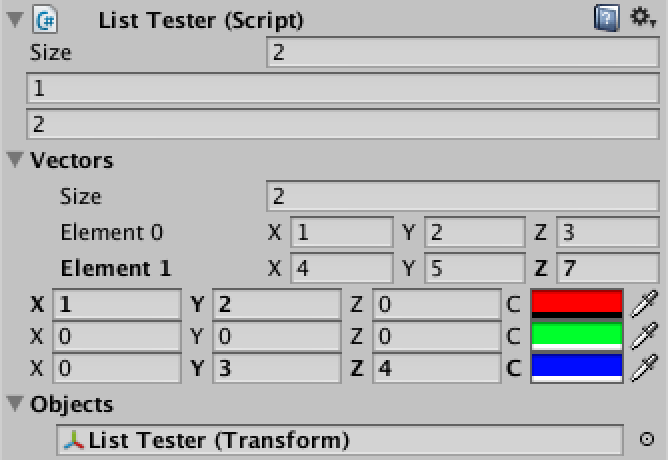
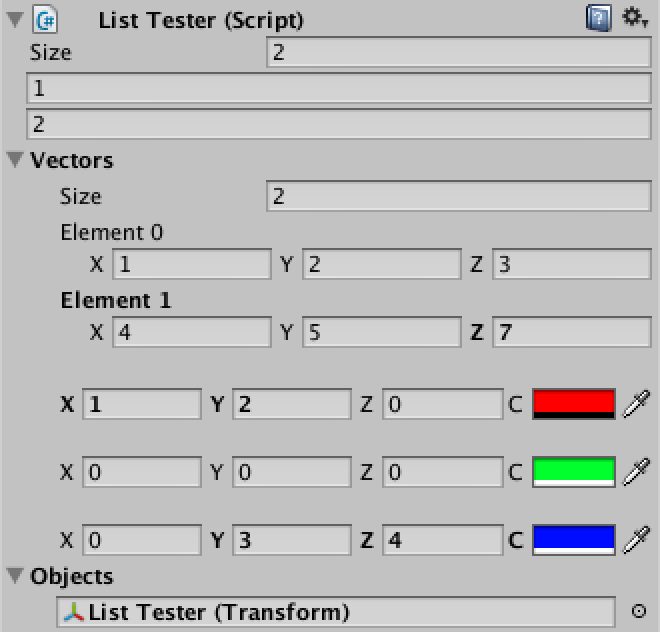
ColorPointDrawer
does not claim an extra line when it does not receive a label.
public override float GetPropertyHeight (SerializedProperty property, GUIContent label) {
return label != GUIContent.none && Screen.width < 333 ? (16f + 18f) : 16f;
}

Adding Buttons
First we'll add an option for buttons, and also a convenient option to activate everything.
[Flags]
public enum EditorListOption {
None = 0,
ListSize = 1,
ListLabel = 2,
ElementLabels = 4,
Buttons = 8,
Default = ListSize | ListLabel | ElementLabels,
NoElementLabels = ListSize | ListLabel,
All = Default | Buttons
}
We predefine static GUIContent for these buttons and include handy tooltips as well.
We also add a separate method for showing the buttons and call it after each element, if desired.
private static GUIContent
moveButtonContent = new GUIContent("\u21b4", "move down"),
duplicateButtonContent = new GUIContent("+", "duplicate"),
deleteButtonContent = new GUIContent("-", "delete");
private static void ShowElements (SerializedProperty list, EditorListOption options) {
bool
showElementLabels = (options & EditorListOption.ElementLabels) != 0,
showButtons = (options & EditorListOption.Buttons) != 0;
for (int i = 0; i < list.arraySize; i++) {
if (showElementLabels) {
EditorGUILayout.PropertyField(list.GetArrayElementAtIndex(i));
}
else {
EditorGUILayout.PropertyField(list.GetArrayElementAtIndex(i), GUIContent.none);
}
if (showButtons) {
ShowButtons();
}
}
}
private static void ShowButtons () {
GUILayout.Button(moveButtonContent);
GUILayout.Button(duplicateButtonContent);
GUILayout.Button(deleteButtonContent);
}
public override void OnInspectorGUI () {
serializedObject.Update();
EditorList.Show(serializedObject.FindProperty("integers"), EditorListOption.ListSize);
EditorList.Show(serializedObject.FindProperty("vectors"));
EditorList.Show(serializedObject.FindProperty("colorPoints"), EditorListOption.Buttons);
EditorList.Show(
serializedObject.FindProperty("objects"),
EditorListOption.ListLabel | EditorListOption.Buttons);
serializedObject.ApplyModifiedProperties();
}
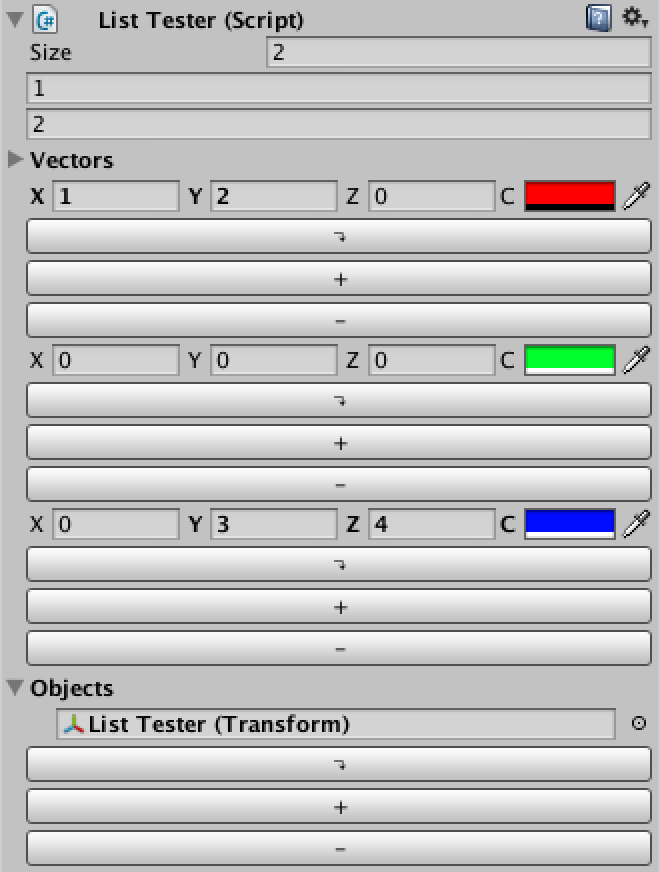
EditorGUILayout.BeginHorizontal and
EditorGUILayout.EndHorizontal.
private static void ShowElements (SerializedProperty list, EditorListOption options) {
bool
showElementLabels = (options & EditorListOption.ElementLabels) != 0,
showButtons = (options & EditorListOption.Buttons) != 0;
for (int i = 0; i < list.arraySize; i++) {
if (showButtons) {
EditorGUILayout.BeginHorizontal();
}
if (showElementLabels) {
EditorGUILayout.PropertyField(list.GetArrayElementAtIndex(i));
}
else {
EditorGUILayout.PropertyField(list.GetArrayElementAtIndex(i), GUIContent.none);
}
if (showButtons) {
ShowButtons();
EditorGUILayout.EndHorizontal();
}
}
}

private static GUILayoutOption miniButtonWidth = GUILayout.Width(20f);
private static void ShowButtons () {
GUILayout.Button(moveButtonContent, EditorStyles.miniButtonLeft, miniButtonWidth);
GUILayout.Button(duplicateButtonContent, EditorStyles.miniButtonMid, miniButtonWidth);
GUILayout.Button(deleteButtonContent, EditorStyles.miniButtonRight, miniButtonWidth);
}
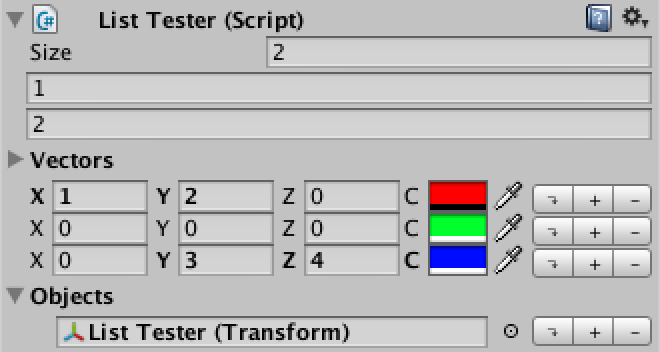
Fortunately, adding functionality
to the buttons is very simple, as we can directly use the methods for array manipulation provided
by SerializedProperty. We need the list and the current element index for this to
work, so we add them as parameters to our ShowButtons method and pass them along
inside the loop of ShowElements.
private static void ShowElements (SerializedProperty list, EditorListOption options) {
bool
showElementLabels = (options & EditorListOption.ElementLabels) != 0,
showButtons = (options & EditorListOption.Buttons) != 0;
for (int i = 0; i < list.arraySize; i++) {
if (showButtons) {
EditorGUILayout.BeginHorizontal();
}
if (showElementLabels) {
EditorGUILayout.PropertyField(list.GetArrayElementAtIndex(i));
}
else {
EditorGUILayout.PropertyField(list.GetArrayElementAtIndex(i), GUIContent.none);
}
if (showButtons) {
ShowButtons(list, i);
EditorGUILayout.EndHorizontal();
}
}
}
private static void ShowButtons (SerializedProperty list, int index) {
if (GUILayout.Button(moveButtonContent, EditorStyles.miniButtonLeft, miniButtonWidth)) {
list.MoveArrayElement(index, index + 1);
}
if (GUILayout.Button(duplicateButtonContent, EditorStyles.miniButtonMid, miniButtonWidth)) {
list.InsertArrayElementAtIndex(index);
}
if (GUILayout.Button(deleteButtonContent, EditorStyles.miniButtonRight, miniButtonWidth)) {
list.DeleteArrayElementAtIndex(index);
}
}
While this is how Unity handles deletion in this case, it is weird. Instead, we want the element to always be removed, not sometimes cleared. We can enforce this by checking whether the list's size has remained the same after deleting the element. If so, it has only been cleared and we should delete it again, for real this time.
private static void ShowButtons (SerializedProperty list, int index) {
if (GUILayout.Button(moveButtonContent, EditorStyles.miniButtonLeft, miniButtonWidth)) {
list.MoveArrayElement(index, index + 1);
}
if (GUILayout.Button(duplicateButtonContent, EditorStyles.miniButtonMid, miniButtonWidth)) {
list.InsertArrayElementAtIndex(index);
}
if (GUILayout.Button(deleteButtonContent, EditorStyles.miniButtonRight, miniButtonWidth)) {
int oldSize = list.arraySize;
list.DeleteArrayElementAtIndex(index);
if (list.arraySize == oldSize) {
list.DeleteArrayElementAtIndex(index);
}
}
}
private static GUIContent
moveButtonContent = new GUIContent("\u21b4", "move down"),
duplicateButtonContent = new GUIContent("+", "duplicate"),
deleteButtonContent = new GUIContent("-", "delete"),
addButtonContent = new GUIContent("+", "add element");
private static void ShowElements (SerializedProperty list, EditorListOption options) {
bool
showElementLabels = (options & EditorListOption.ElementLabels) != 0,
showButtons = (options & EditorListOption.Buttons) != 0;
for (int i = 0; i < list.arraySize; i++) {
if (showButtons) {
EditorGUILayout.BeginHorizontal();
}
if (showElementLabels) {
EditorGUILayout.PropertyField(list.GetArrayElementAtIndex(i));
}
else {
EditorGUILayout.PropertyField(list.GetArrayElementAtIndex(i), GUIContent.none);
}
if (showButtons) {
ShowButtons(list, i);
EditorGUILayout.EndHorizontal();
}
}
if (showButtons && list.arraySize == 0 && GUILayout.Button(addButtonContent, EditorStyles.miniButton)) {
list.arraySize += 1;
}
}
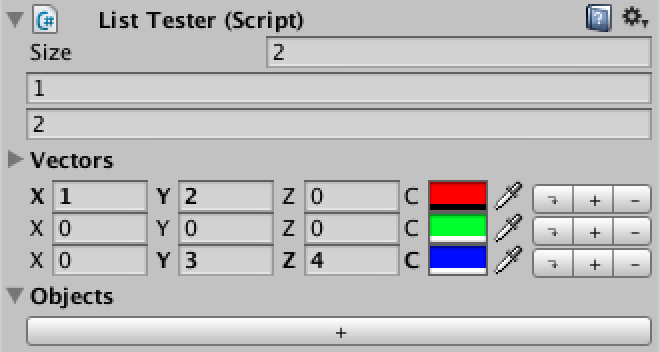
Only Allowing Lists
ListTester that is not a list.
public int notAList;
ListTestInspector.
public override void OnInspectorGUI () {
serializedObject.Update();
EditorList.Show(serializedObject.FindProperty("integers"), EditorListOption.ListSize);
EditorList.Show(serializedObject.FindProperty("vectors"));
EditorList.Show(serializedObject.FindProperty("colorPoints"), EditorListOption.Buttons);
EditorList.Show(
serializedObject.FindProperty("objects"),
EditorListOption.ListLabel | EditorListOption.Buttons);
EditorList.Show(serializedObject.FindProperty("notAList"));
serializedObject.ApplyModifiedProperties();
}
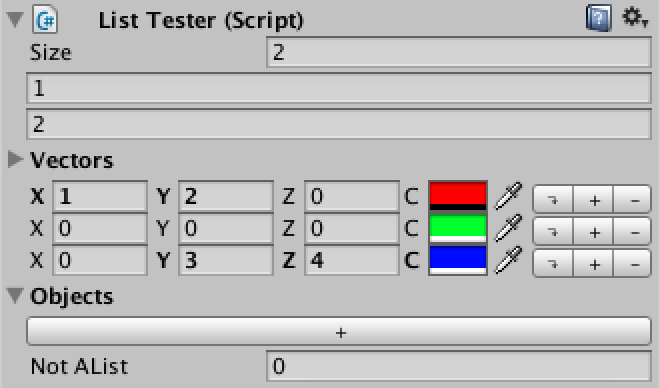
public static void Show (SerializedProperty list, EditorListOption options = EditorListOption.Default) {
if (!list.isArray) {
EditorGUILayout.HelpBox(list.name + " is neither an array nor a list!", MessageType.Error);
return;
}
bool
showListLabel = (options & EditorListOption.ListLabel) != 0,
showListSize = (options & EditorListOption.ListSize) != 0;
if (showListLabel) {
EditorGUILayout.PropertyField(list);
EditorGUI.indentLevel += 1;
}
if (!showListLabel || list.isExpanded) {
if (showListSize) {
EditorGUILayout.PropertyField(list.FindPropertyRelative("Array.size"));
}
ShowElements(list, options);
}
if (showListLabel) {
EditorGUI.indentLevel -= 1;
}
}

Multi-object Editing

CanEditMultipleObjects attribute to our ListTesterInspector.
[CustomEditor(typeof(ListTester)), CanEditMultipleObjects]

public static void Show (SerializedProperty list, EditorListOption options = EditorListOption.Default) {
if (!list.isArray) {
EditorGUILayout.HelpBox(list.name + " is neither an array nor a list!", MessageType.Error);
return;
}
bool
showListLabel = (options & EditorListOption.ListLabel) != 0,
showListSize = (options & EditorListOption.ListSize) != 0;
if (showListLabel) {
EditorGUILayout.PropertyField(list);
EditorGUI.indentLevel += 1;
}
if (!showListLabel || list.isExpanded) {
SerializedProperty size = list.FindPropertyRelative("Array.size");
if (showListSize) {
EditorGUILayout.PropertyField(size);
}
if (size.hasMultipleDifferentValues) {
EditorGUILayout.HelpBox("Not showing lists with different sizes.", MessageType.Info);
}
else {
ShowElements(list, options);
}
}
if (showListLabel) {
EditorGUI.indentLevel -= 1;
}
}

Downloads
- custom-list.unitypackage
- The finished project.